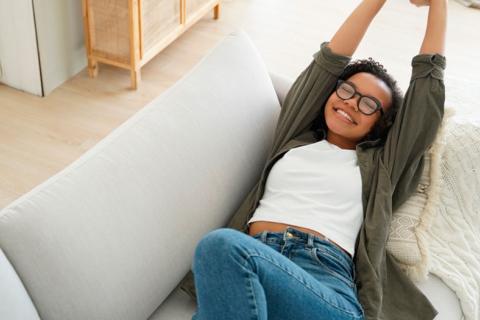
When we are faced with complicated situations or we have to make an important decision, we can follow the advice that says to “sleep on it”, that is, to wait until the next day before acting because sleep can help us find the best solution. Now, a new study has revealed that our creativity reaches its peak in the first phase of sleep, just when we just fell asleep, and that waking up after a short nap makes it easier to develop creative ideas.
Researchers from MIT and Harvard Medical School have shown for the first time that when people are asked to dream about a specific topic during that stage of sleep, they perform much more creatively when asked to do three creativity tasks on that topic. “When you are asked to dream about a topic during dream onset you may have dream experiences that you can then use for these creative tasks,” he explained. Kathleen Esfahanyan MIT senior and one of the study’s lead authors.
The prompt to dream about something in particular is known as “directed dream incubation,” and individuals who received it developed more creative stories than those who napped without receiving this prompt, or those who stayed awake. The results of the study have been published in Scientific Reports and suggest that during this first stage of sleep the brain establishes broader connections between disparate concepts, which provides a boost to creativity, “If you access this brain state, you can be more creative during wakefulness,” says Adam Haar Horowitz, a postdoc at the MIT Media Lab and lead author of the study.
The onset of sleep encourages creative ideas
The onset of sleep, known as stage N1 or hypnagogia, was already considered a particularly fertile moment for creative ideas, and a study by the Paris Brain Institute published in Science Advances in 2021 showed that it contributes to generating this type of creative perception, since participants who fell into N1 for a short time were much more likely to discover an easy way to solve a number-related task.
People who took a nap with directed dream incubation solved tasks 78% more creatively than those who stayed awake
The authors of the new paper wanted to see if they could extend that finding to domains more associated with creativity, such as storytelling, and if it was possible to guide the content of people’s dreams and how that guided content might influence the way they dream. creative process. To do this, they developed a device called Dormio that could be used to incubate specific dreams.
The device includes a glove that measures three physiological markers of sleep—changes in muscle tone, heart rate, and skin conductance—and communicates them to a smartphone or laptop app. When an individual with the glove enters the N1 state, the app asks them to dream about a certain subject and after a few minutes, when the user starts to fall into the next stage of sleep, the app wakes them up, asks them for information. about what he was dreaming about and records his answer.
The researchers divided 49 participants into four groups. One group had 45 minutes to nap; the Dormio device prompted them to dream of a tree and then recorded the description of their dreams. Each time a dream was reported, the user was encouraged to go back to sleep and asked again to dream of a tree.
Participants in another group who also used the device while napping were instructed to observe their thoughts. Two other groups stayed awake for the 45 minutes: one group was told to think about trees and the other was told to watch their thoughts.
After napping or staying awake, they asked all the participants to carry out three tasks that had been previously established to correlate with creativity. The first consisted of storytelling, in which they were asked to write a creative story that included the word ‘tree’. The results showed that people who were given instructions to dream about trees developed the most creative stories, and that people who took a nap but were not specifically prompted also showed more creativity than those who stayed awake for the entire experiment. .
The people who were asked to dream about trees also scored the highest on two other measures associated with creativity, known as divergent thinking tasks. In one, participants were asked to list all the creative uses they could think of for a tree, and in the second, people were given a list of nouns and asked to respond with the first verb they came up with. came to mind for each one.
When researchers looked at all three tasks, participants who napped with directed dream incubation completed them 43% more creatively than those who napped without directed dream incubation, and 78% more creatively than those who napped without directed dream incubation. who stayed awake. They also found that in the group of people who were told to dream about trees, those who had a greater number of dreams about trees also showed more creativity in their stories, and also incorporated much of the content of their dreams into their stories. his stories.
“That evidence suggests that it’s not just being in the N1 dream state that makes people more creative. People are more creative because they also tap into the dreams they have in that dream state,” Esfahany says. These scientists are now investigating whether they can extend their dream incubation protocol to later stages of sleep, such as REM, and whether it would be useful for treating nightmare-related distress.
.